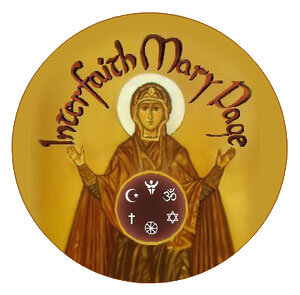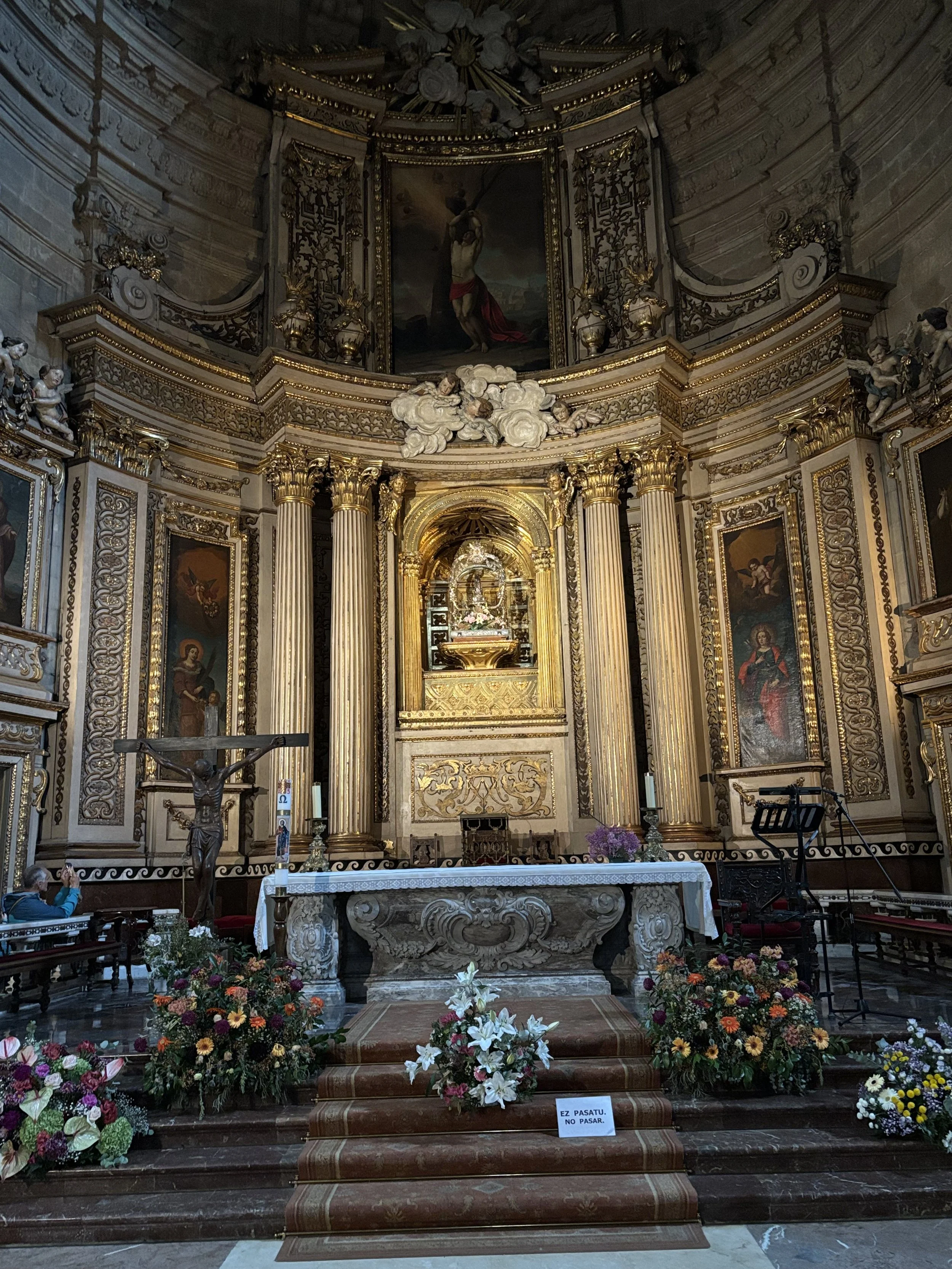San Sebastian, Spain
Santa Maria del Coro, Our Lady of the Choir,
Patroness of San Sebastian
Basilica of Santa Maria del Coro, Calle 31 de Agosto, 46, 20003 Donostia - San Sebastian, Basque Country, 30cm/11.8 inches.
Article and photos by Leontine Hartzell
Our Lady of the Choir, patroness of the seaside city of San Sebastian, is small, only 30 centimeters tall or 11.8 inches, surrounded by gilded decorations in an elaborate golden altarpiece which is situated high above the main altar in a recessed alcove. She is the smallest statue in the elaborately decorated Baroque cathedral.
Her gilded altar piece has the Holy Spirit as a dove above her, and four seated crowned kings or “domos”, as they are called at the church (from the Latin: a person who serves the Lord) surrounding her in adoration. On either side of her altar are painted panels of four women saints: Magdalena, Ursula, Dorotea and Marta. The Madonna is black skinned with silver painted robes and cradles a black child who is sucking his two middle left fingers. Both Madonna and child have silver filigree crowns on their heads. The Madonna’s crown is highlighted by a central red jewel. Elaborate swirling loops and curves adorn her painted silver robes.
The child leans slightly forward from the Madonna’s arms, its right arm stretched out in a relaxed drape over the Madonna’s covered bosom. The baby looks outward, as if to connect with one who gazes back, while the Madonna looks serenely down and forward.
It is interesting to note that Mari, one of the oldest goddess figures in Europe, the supreme goddess of Basque mythology, was often described as a woman dressed in red. Perhaps as homage to the native beliefs, red was chosen as the jewel in the Madonna’s crown.
As a psychic I felt a strong positive energy at the main altar below the Madonna and a confluence of energy ley lines which manifested as a tingling throughout my head, an activation of my crown chakra with strong energetic tingling and a vibration of energy that felt light and uplifting throughout my whole body.
It is probable that there was an ancient pre-Christian holy site before the first Christian church was built here in the 12th century. That church burned down, and a second church of the 16th century was badly damaged after a munitions explosion in the castle behind the church. The current basilica was built between 1743-1774.
This type of Madonna with a finger sucking child is rare but is sometimes found in statuary from the Renaissance period from the 14th to the 17th century.
History of the Statue and her People
Local legend has it that she appeared miraculously floating on the water. (After all, every real Black Madonna needs a supernatural aspect.) But historically speaking, she originated in Renaissance Italy in 1509-1515, was taken to Venezuela and was there for some time and then brought to San Sebastian on a merchant ship. San Sebastian had a large cacao trade with Venezuela in the 18th century, so ship movement between the two countries was frequent. During this time large plantations in Venezuela were worked primarily by enslaved Africans since much of the indigenous population had died from enslavement and diseases introduced by the invading Spanish. The prosperous cacao trade completely relied on kidnapped enslaved African laborers for its success.
The Spanish were the first Europeans in Venezuela in 1502. In 1527 the city of Coro was founded as the capital of Venezuela. Later in 1577 the capital was moved to Caracas. In the Caquetio indigenous language of Venezuela, “coro” comes from the word curiana, meaning “place of winds.” The city of Coro was originally named by the Spanish as Santa Ana de Coro combining a Spanish Catholic saint name with the Caquetio.[i] “Coro” also means “choir” in Spanish.
The history of San Sebastian Basilica holds that Our Lady is called Santa Maria del Coro because she used to be in the choir of their church but was moved to rest above the main altar sometime after the second church was severely damaged in 1688.
The story given to me by a church doyenne (the woman who was an authority on the church history) is that a monk wanted to remove the Madonna from the church altogether but that the Madonna told him “you don’t want to do that, this is my place.” She has had her place of honor above the main altar ever since.
We can speculate that perhaps the Madonna was put in the choir area of the Basilica because the word “Coro” was part of her name, which was because of the city she came from in Venezuela. Perhaps the Spanish priest who received her from a ship captain thought that was where she was meant to be because of her name. And perhaps she not only represents the dark Mother of the Underworld, rich with fecundity and nurturance, dark as the dirt beneath our feet, as ancient goddesses do, but also represents an African queen enslaved in Coro, Venezuela.
Concurrent with the time of the Madonna being placed in the main church, there was a movement within the Basque people against the Christian religion. The Spanish Inquisition trials of the 17th century to eliminate Basque pre-Christian beliefs and practices accused 30,000 Basques, including Catholic priests, of witchcraft and persecuted 7,000 native people.
Once 5,000 fishermen, returning home from New Foundland, discovered that their loved ones had been burned, and started a riot.[ii]
It is no coincidence that this is the time frame when the Madonna del Coro was moved to the central altar of the basilica to encourage Christian belief while silently honoring the dark earth mother.
Santa Maria del Coro is the patroness of the city of San Sebastian. Her feast day is September 8th and on that day she is lowered by her special elevator from behind the main altar in a rear chapel and placed lower down on a pedestal on the main altar to be closer to the people. Her devout followers believe: “You can ask her for whatever you need and she will provide it to you.”
The Land Around Her
photo: UMass Lowell blog
The Basilica is built at the base of the 123 meter high Mt. Urgull, which overlooks the city of San Sebastian. Since the basilica is built at the base of Mt. Urgull and it is on an isthmus between the small peninsula Mt. Urgull occupies and the mainland with its protected ocean bay, it geographically indicates the probability of a confluence of energetic earth ley lines.
A small mountain next to the ocean on an isthmus of land is an unusual geographic feature of the earth. It is an energetic power place, a vortex of energy. The intersection of these distinct geological features: the narrow land of the isthmus, the mass of the mountain and the fluid forces of the ocean create a concentrated convergence of telluric earth energy ley lines flowing around the geographical features of the landscape. This is why, when I stood at the altar in the Basilica, I felt my whole body vibrating and tingling.
Since ancient times the seers and wise ones could sense and feel a power place such as where this Basilica rests. In ancient times these places would often be tended to by earth energy healers who would work with the ley lines to bring balance to the earth. These power vortexes would be places of ceremony, healing and prophecy. The Basque heritage of the region was highly matriarchal and focused on worshipping the divine feminine in the guise of Mari, the supreme goddess. We can speculate that this is why the Basilica was built here and that perhaps it was known as an ancient holy place, so the Christians built their church there to convert the local populace to their religion. And to connect the Basque mother goddess worship with Catholicism, the dark Madonna and child was installed to continue the focus on divine mother energy, love and nurturance.
I stood and enjoyed this blessing of this holy place with gratitude for the divine feminine energies of the universe.
Footnotes:
[i] Karen Larkins, Smithsonian Magazine, March 2009, Endangered Site: Port City of Coro, Venezuela, Archived 2012-06-17 at the Wayback Machine, cited in https://en.wikipedia.org/wiki/Coro,_Venezuela#cite_note-3
[ii] Vamzzz, “The Ancient Witch-Cult of the Basques, 2017, Occult Blog, https://vamzzz.com/blog/basques-witch-cult/






